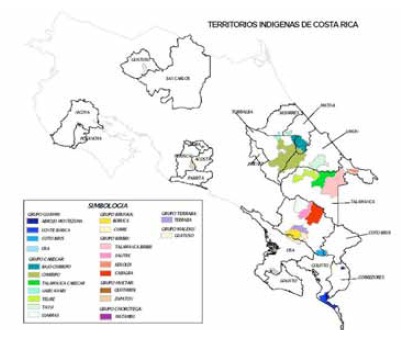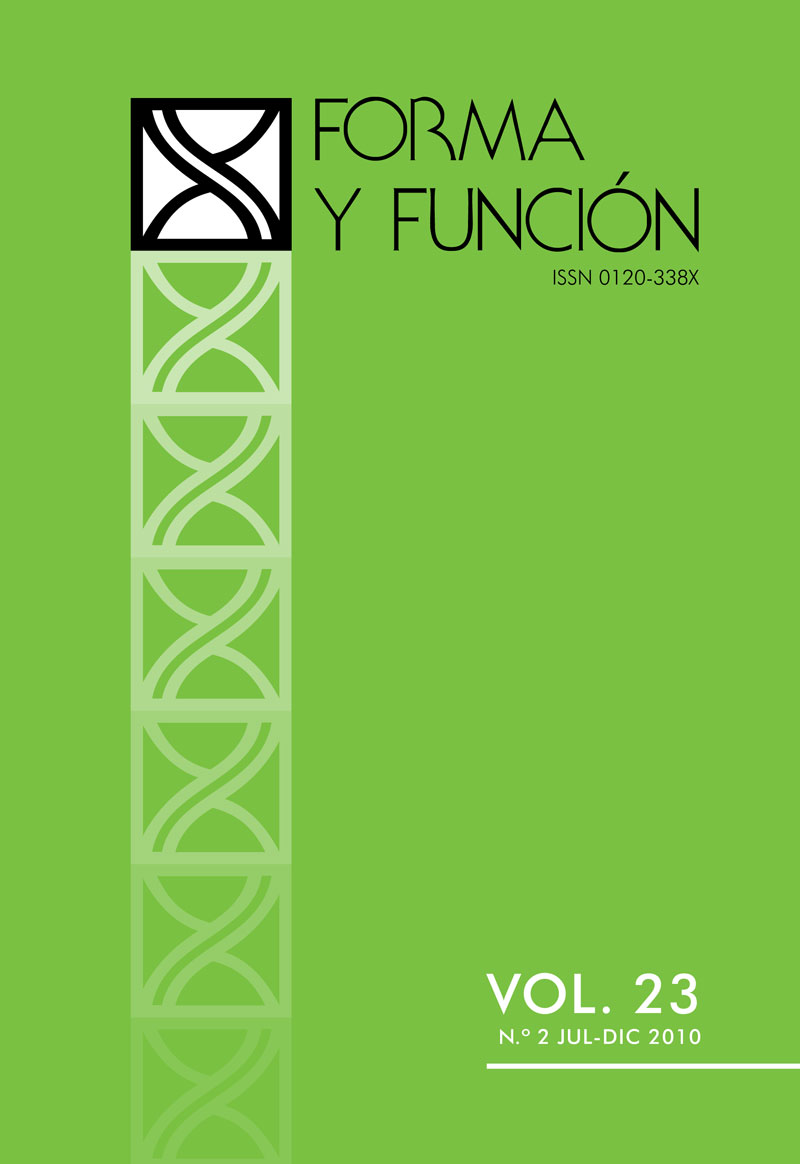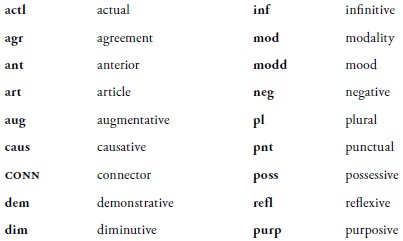The complex clause in Boruca
Palabras clave:
asyndesis, complex clause, hypotaxis, parataxis, syndesis (es)
Descargas
THE COMPLEX CLAUSE IN BORUCA*
LA ORACIÓN COMPLEJA EN LA LENGUA BORUCA
Damaris Castro
Universidad Nacional de Costa Rica, Costa Rica
dcastro@una.ac.cr
Artículo de revisión recibido 22-02-2011, artículo aceptado 04-04-2011
Abstract
This paper describes the complex clause in Boruca, a Chibchan language once spoken in the southern territories on the Pacific coast of Costa Rica. The present study concentrates on the behavior of complex clauses, following a major distinction between paratactic and hypotactic constructions. Paratactic constructions are divided into asyndetic and syndetic constructions. The latter are quite frequent and it is common to find the syndetons: mang, ní, ihchí and iné in the combination of sentences in regular speech. Hypotactic constructions also have asyndetic and syndetic constructions usually functioning as object complements. There is also evidence for reported speech, indirect questions and adverbial clauses (classified at least into seven different types).
Key words: asyndesis, complex clause, hypotaxis, parataxis, syndesis.
Resumen
El artículo describe la oración compleja del boruca, una lengua chibcha que se habló en los territorios del Pacífico Sur en Costa Rica. El estudio se centra en el comportamiento de las proposiciones complejas, a partir de la distinción principal entre construcciones paratácticas e hipotácticas. Las construcciones paratácticas se dividen en sindéticas y asindéticas. Estas últimas son bastante frecuentes, y el uso de los conectores mang, ní, ihchí e iné es también bastante utilizado en la combinación de frases del lenguaje común. Las construcciones hipotácticas también presentan asindesis y sindesis, las cuales suelen funcionar como complementos de objeto. Hay también evidencia de discurso directo e indirecto, preguntas indirectas y construcciones adverbiales (clasificadas en siete tipos diferentes).
Palabras clave: asindesis, hipotaxis, oración compleja, parataxis, sindesis.
Introduction
BORUCA, AN INDIGENOUS language of Costa Rica, has only recently begun to be considered a dead language. Although the language is not spoken in the communities, the indigenous reserve still occupies the same region. The people are divided mainly into two reserves: Boruca and Curré. In contrast to what happened with other indigenous groups here, this group still remains in the original territories that they occupied before colonial times. They were not moved to other lands, as were the Bribris, for example. According to Solano (2000), the Boruca population amounts to 2017 inhabitants: 1386 in Boruca and 631 in Curré (see figure 1). The last native speaker of the language died in 2003, thus allowing the language to reach an extreme point in its obvious decay, which was evident since the 1980s, and giving way to its imminent death. Currently there is one remaining semi-speaker of the language; the other one (his wife) passed away in 2007. This last elder semi-speaker grew up having quite a strong contact with the language, but this contact was not strong enough for this language to be his first and most important means of oral communication. Although there are many people in the community who claim to partially understand the language, they are not able to produce sentences or even phrases in Boruca. Spanish is, by far, the language of choice for people in the community.

Figure 1. Map of the indigenous languages and their territories in Costa Rica.
Source: Centro Centroamericano de Población (2000).
This is the first in-depth study on the complex clause in Boruca. There are several other very general descriptions of the language: Constenla & Maroto (1986) and Quesada Pacheco (1995, 1996). These serve as secondary sources supporting this analysis of the Boruca complex clause. Only Quesada Pacheco (1995) discusses complex sentences, albeit to a rather simple extent. The present study addresses clause linkage in Boruca, in relation to complex clauses, following the traditional distinction between parataxis and hypotaxis. These phenomena will be dealt with along the lines of Lehmann (1998, p. 181), who points to desententialization of the second clause as a phenomenon closely linked to parataxis, and argues in favor of the hierarchical downgrading of the dependent clauses, a matter closely related to hypotaxis. Thus, complex sentence formation will be conceived as "varying between the poles of elaboration and compression." Elaboration will be represented here through various types of syndetic constructions while compression will be associated with asyndetic constructions. Following this organization, the information presented below will be divided into two major sections: paratactic and hypotactic constructions. Paratactic constructions refer to the coordination of elements of a sentential nature while hypotaxis has to do with a dependency relation of one clause or sentence on another clause or predicate, thus understood as subordination. Paratactic constructions are in turn divided into asyndetic (juxtaposed) and syndetic constructions, the latter usually linked by the connectives mang, iné, ihchí and ní. The section on hypotactic constructions will be further divided into complement and adverbial clauses. The first are not too common and they represent arguments of the predicate. The latter, although exhibiting more variety, do not usually represent arguments of predicates. Both syndetic and asyndetic hypotactic constructions are described on the basis of their functions, as arguments in the case of complement clauses or as adjuncts in the case of adverbial clauses. Relative clauses are considered nominal modifiers; thus, given that they are not adverbial or complement clauses, they are not included as part of this section.
1. Paratactic Constructions
1.1. Asyndesis
Asyndetically coordinated sentences in Boruca may or may not have elements in common. An example of the latter is illustrated in (1); note that the clauses do not have arguments or verbs in common. In the remaining examples below, there are shared elements; these can be arguments as in (2) í', or (3) yubú. Arguments can be overtly expressed as in (2), or they can be expressed anaphorically, via ø anaphora as in (3) and (4). The shared element can also be a verb or verb phrase, where the verb can be overtly expressed as in (5).
(1) Káhwik Kwasráng ki ká o-krá yo brú' ki. Kak ki ro'-krá.
Far Kwasráng SPEC from finish-PNT rain big DEF. Sun DEF shine-PNT.
'Far from Kwasráng, the big rain finished. The sun shined.' (Constenla & Maroto, 1986, p. 94)
(2) Drik kráng ki i' wíkra di' ka, i ki de-krá ihnéng.
Money AUG DEF 3SG take-PNT river to, 3SG SUBJ leave-PNT nothing.
'He took a lot of money to the river. He left with nothing.' (Quesada Pacheco, 1996, p. 64)
(3) I' ramróhk é'dé yubú' yáng-íra, yubú' ki oh-íra.
POSS woman with chicha1 drink-DUR, chicha DEF drip-DUR
'With his wife (he) drank chicha, (he) dripped (prepared) chicha.' (Quesada Pacheco, 1996, p. 71)
(4) E'tsi ramróhk ki kawí'ra we'é. Chubú kam kí bing-íra breát breát.
One woman SPEC live-ACTL here. Cotton thread DEF warp-DUR a.lot a.lot.
'One woman lived here. (She) warped a lot of cotton thread.' (Quesada Pacheco, 1996, p. 70)
(5) We'é i' ramát ki koht-krá, wé'é í ki kohd-ra.
Here POSS wife SUBJ die-PNT, here 3SG SUBJ die-ACTL.
'His wife died here, he (will) die here.' (Constenla & Maroto, 1986, p. 58)
1.2. Syndesis
Syndetic constructions behave similarly to asyndetic constructions, the only difference being the presence of a syndeton. The most common syndetons in Boruca are: mang, ní, ihchí and iné. Boruca exhibits a conspicuous tendency to use syndetic constructions. Clauses which have no elements in common can be linked as in (6) and (7). There are also cases where there can be elements in common. If the shared element is an argument, it can be expressed as an anaphora: either as a personal affix (i, 3SG) as in (8), a pronoun as in (9), or a zero anaphora as in (10). It is also possible to share a verb or verb phrase as in (11), where the verb may be left unexpressed (12) without rendering the sentence ungrammatical.
(6) Bak róhk ki de-krá yaba' í', mang i-ng, i' aht-krá i' reshí.
Owner PL DEF go-PNT hill to, and 3SG-FOC, 3SG stay-PNT 3SG alone.
'The owners went to the hill, and he, he stayed alone.' (Quesada Pacheco, 1996, p. 60)
(7) Dabag-ír-í-ng róhk, iné káng k si'án-írá.
Arrive-DUR-3PL-AGR PL, and stone DEF disappear-DUR.
'They arrived and the stone had disappeared.' (Constenla & Maroto, 1986, p. 122)
(8) Mang abí bóhk ki i kún tsít ki kruh-krá, mang i káng Tsít ki tsáng-kr-i ká, mang i shúng-kr-i ká.
Then person young.man DEF POSS sling DIM SPEC take-PNT, and POSS stone DIM SPEC put-PNT-3SG in, and 3SG throw-PNT-3SG to.
'Then the young man took his sling, and he put his little stone in and he threw it at her.' (Quesada Pacheco, 1996, p. 48)
(9) Ramróhk ki trú'-ir-í-ng i e'dé, mang ing cohd-íra i' é'dé.
Woman DEF join-DUR-3SG-AGR 3SG with, and 3SG-AGR die-DUR 3SG with.
'The woman, she joined him and she died with him.' (Quesada Pacheco, 1996, p. 71)
(10) I kí ang daba-krá di' kák tá ihchí é'tse wá' ki ba-krá.
3SG SUBJ FOC arrive-PNT POSS place in and one child SPEC have-PNT.
'He arrived in our town and (he) had one child.' (Constenla & Maroto, 1986, p. 96)
(11) A'd beyáng-r-i-ng, ní át ki i' beyáng-ra i do'sh.
1SG want-ACTL-3SG-AGR, and 1SG SUBJ 3SG want-ACTL 3SG too.
'He loves me and I love him too.'(Quesada Pacheco, 1996, p. 77)
(12) Entonces, i' wá' bush ki shit-krá ní wá' bóhk ki i' dó'sh.
Then, POSS child girl SUBJ laugh-PNT and child boy DEF 3SG too.
'Then her girl laughed and the boy did too.' (Quesada Pacheco, 1996, p. 73)
As illustrated in (11) and (12) above, ní coordinates clauses; however, this morpheme also serves to subordinate a clause, as illustrated in (13). Whether it is a coordinator or subordinator is expressed by the meaning of the conjuncts or the subordinated sentences in their corresponding functions in the given context.
(13) Ramróhk búsh ki kraé'kra ni i' wá' ki baw'íra.
Woman young DEF observe-PNT that POSS child SPEC be.born-DUR.
'The woman observed that her own child was being born.' (Quesada Pacheco 1995, p. 111)
Moreover, iné aside from expressing coordination as in (7) above, may also express opposition; in such cases, the context determines the semantics and functions of this morpheme. See (14) below for an example of contrastive information.
(14) I shang-chá-ír-í-ng, iné i bot ki yikrá do'i'sh-ira.
3SG shoot-want-DUR-3SG-AGR, but POSS shotgun SUBJ fire give-NEG-DUR.
'He wanted to shoot him, but his shotgun didn't fire.' (Literally: 'didn't give fire') (Constenla & Maroto, 1986, p. 88)
2. Hypotactic Constructions
2.1. Asyndetic Complement Clauses
Subject complement clauses are not identifiable in Boruca. Asyndetic complement clauses are usually objects of the complement, with verbs of saying, perception and others. Observe how in (15) below there is no connector to introduce the complement clause (i' wá' ki baw'íra); in the second case (16), the complement clause preceding the verb (beyangí'shíring) does not have the connector either.
(15) Ramróhk búsh ki kraé'kra i' wá' ki baw'-íra.
Woman young DEF observe-PNT POSS child SPEC be.born-DUR.
'The woman observed (that) her child was being born.' (Quesada Pacheco, 1995, p. 112)
(16) Íní' í-ng yá'shi kawí'kra róhk, kóngróhk róhk krabé' a vér si í-ng i kruhg-írá róhk yét, ramróhk róhk ang yabáhg-írá yá Róhk
Since 3PL-AGR like.this 'live-PNT PL, man PL watch to see if 3PL-AGR 3PL catch-DUR PL PURP, woman PL CONN pass-DUR DEM PL
ki beyang-í'sh-ír-i-ng róhk.
SPEC want-NEG-DUR-3PL-AGR PL.
'Since they lived like this, watching men to see if they could catch them, they didn't want the women (that) passed by there.' (Constenla & Maroto, 1986, p. 62)
2.2. Syndetic Complement Clauses
Syndetic complement clauses are also objects of complement-taking verbs and they are introduced by the connective ní (ni) (17). Towards the end of the existence of the language there was a rather widespread use of the Spanish connective ke ('that') in substitution of the Boruca form ní; see (18) below.
(17) Ramróhk búsh ki kraé'kra ni i' wá' ki baw'íra.
Woman young DEF observe-PNT that POSS child SPEC be.born-DUR.
'The woman observed that her own child was being born.' (Quesada Pacheco, 1995, p. 111)
(18) At ki te-krá ke do' do' kráng róhk ki og-íra.
1SG subj say-PNT that soon soon tree PL DEF disappear-DUR.
'I said that soon the trees (will) disappear.' (Quesada Pacheco, 1995, p. 111)
2.2.1. Reported Speech
There are two rather common ways of expressing reported speech in Boruca. Reported speech clauses can be divided into non-literal reported speech and quoted reported speech. In the first, complement clauses indicating reported speech are, in terms of syntax, objects of the verbs used to express indirect speech. The most common verb used to introduce reported speech is tek, te ('say') as in (19) and (20). In these constructions the clause expressing reported speech follows the main clause.
(19) Te-kr-i-ng róhk: 'tsu'-krá yá ki tebek i' wá.
Say-PNT-3PL-AGR PL: 'scape-PNT DEM SPEC snake POSS son.
'They said: The son of that snake escaped.' (Constenla & Maroto, 1986, p. 58)
(20) Antónces bó's róhk ki ang te-rá: 'deg-rá di-ng i kwin-í kawik.
Then wizards pl def FOC say-actl: 'go-actl 1PL-agr pl put-ING far.
'Then the wizards said: We will go to drop them far (away).'(Constenla & Maroto, 1986, p. 66)
The second type of reported speech mentioned above is quoted or literal reported speech. The first possibility is to have verbs such as yuak ('yell') or tek ('say') immediately followed by a direct quote; see (21) below. The second type, and by far the most common way of expressing quoted speech is through the use of the postposition ka ('to') in a clause where the main verb has been deleted. Most commonly the subject and the object are expressed in the first clause; the verb, however, is omitted in this clause. In these main clauses, full nouns may function as the subject of these clauses and pronouns as objects (21), pronominal subjects and objects are found (22), or the sentence may have only the object of the clause, leaving the subject unexpressed (23). Finally, the order or these clauses may alternate, presenting the reported speech clause following the main clause as in the examples of the non-literal reported speech above; or they may have the reported speech clause in sentence initial position as in (24).
(21) I ki kasá'-írá: '¿í ugé' b-ing at churuká'-ra.'
3SG SUBJ yell-DUR: '¿what for 2SG-AGR 1SG tickle-ACTL'
'She yelled: "Why are you tickling me?".' (Constenla & Maroto, 1986, p. 72)
(22) Kuréwá ki i ká: 'at ki deg-í'sh-a.'
Kuréwá SUBJ 3PL to: 1SG SUBJ go-NEG-ACTL
'Kuréwá to them: "I am not going".' (Literally 'I do not go') (Quesada Pacheco, 1996, p. 54)
(23) I róhk ki i ká: 'chí' suhróhk tsít abí déng ka di'róhk ki do'á-ra.
3PL PL SUBJ 3SG to: 'DEM elder DIM EMPH behind to 1PLPL SUBJ CONT-ACTL.
'They to him: "We come behind (following) that little old man".' (Quesada Pacheco, 1996, p. 81)
(24) Mang i' be ki ka, 'mí'rang ka, mí'rang ka.'
Then POSS mom SPEC to, 'go to, go to
'Then, to his mom: "Go, go".' (Quesada Pacheco, 1996, p. 73)
(25) 'Moréng-r-i-ng', i ká Loréto ki.
'Good-ACTL-3SG-AGR', 3SG to Loréto SPEC.
'"That's good," he (said) to Loreto.' (Quesada Pacheco, 1996, p. 114)
2.2.2. Indirect Questions
Indirect questions are also present in Boruca. These are usually marked by the Spanish complementizer ke ('that') which usually integrates the clause with the main verb as in (tekrá), in example (26) below. In the second example (27), the Spanish form sábe ('who knows?') is used to express the indirect question; in this case the connector that is used is ang.
(26) Di abí te-krá ke kákba nengwáhk ke chah-rá?
Who EMPH say-PNT CONN day first DEF today?
'Who said that today was the first day?' (Quesada Pacheco, 1996, p. 152)
(27) Sábe í ang i' óng-kra?
Know 3SG CONN 3SG do-PNT?
'Who knows what he did?' (Constenla & Maroto, 1986, p. 116)
2.3. Adverbial Clauses
Simultaneous and causative clauses are the only types of clauses that allow the apodosis to appear before the main clause; the rest of the clauses exhibit a protasis-apodosis order. The following represent the main types of adverbial clauses in Boruca.
2.3.1. Conditional Sentences
The original conditional sentences are formed using the word angká ('then','however', 'on the contrary') at the beginning of the apodosis. As in (28) and (29), the adverbial clause always follows the main clause in these constructions.
(28) Yó ki tru'rá, angká ógé róhk ki ya' sé-ra.
Rain SUBJ fall-ACTL, then all PL SUBJ REFL get.wet-ACTL
'If it rains, then everybody gets wet.' (Literally: 'It rains then everybody gets wet.') (Quesada Pacheco, 1995, p. 117)
(29) Juan ki dabag-rá, angká di-ng i' wí'-ra dí' bang ká i.
Juan SUBJ arrive-ACTL, then 1PL-SUBJ 3SG take-ACTL river bank to in.
'If Juan comes, then we take him to the river bank.' (Quesada Pacheco, (1995, p. 117)
Nevertheless, these conditional sentences are rarely found in the available Boruca literature. They have been progressively replaced by forms that look increasingly like the Spanish conditional sentences, even adopting the Spanish conditional marker si ('if'), at the beginning of the first clause. Observe how in (30) si ('if'), is used in the first clause although the second clause still keeps the Boruca marker angká at the beginning of the second clause. However, in example (31) the Boruca marker angká is eliminated and the conditional is expressed through the use of the Spanish marker 'si' only. In these examples, we can see the progression of the Boruca language loss and the transition to Spanish.
(30) Si ya'sróhk bush ki che'át-irá, angká i bahdí ki kwíng kri'éh-irá.
If young girl SUBJ sick-CONT, then 3SG punishment SPEC AUG grow-du
'If the young girl was sick, then her punishment was greater.' (Constenla & Maroto, 1986, p. 124)
(31) Si yá ki tebek tsít róhk ki ba'-ra we'é, wá ki ahd-rá yabá.
If DEM SPEC snake odim PL SUBJ be.born-ACTL here, DEM SPEC remain-ACTL lake.
'If these snakes are born here, this will become a lake.' (Quesada Pacheco, 1995, p. 117)
2.3.2. Purposive Clauses
There are two types of purposive clauses in Boruca: implicit and explicit clauses. Implicit clauses lack a purposive marker, and according to Quesada Pacheco (1995, p. 120), the second verb lacks TAM markers as well, but it could optionally carry the infinitive marker (-í); see (32) and (33).
(32) Rahd-rá di-ng ábu' dí' kahk í.
Leave-ACTL 1PL-SUBJ swim river bank in.
'We left to swim in the river.'(Quesada Pacheco, 1995, p. 120)
(33) Daba-kr-í-ng kab-í di' kába.
Come-PNT-3SG-AGR sleep-ING 1PL house.
'He came to sleep in our house.' (Quesada Pacheco, 1995, p. 120)
Explicit purposive clauses are different from the above clauses in that they have purposive markers. Among these, by far the most common purposive clauses, chá ('for', 'in order to') is placed at the beginning of the clause and most commonly (but not always) yét ('for') comes at the end, as in (34). The subject of these clauses is always marked by the focus marker ang.
(34) Iné i-ng i' wí-kra i' ú í, ch-i-ng i dobóhg-írá yét.
Then 3SG-SUBJ 3SG take-PNT 3SG house to, PURP-3SG-SUBJ 3SG raise-DUR PURP.
'Then, he took him to his house, for him (the father) to raise him (the child).' (Constenla & Maroto, 1986, p. 96)
The regular order of purposive clauses is altered in certain cases. In one type of construction, the purposive clause can appear after the subject of the main clause (35), and the main verb appears after the purpose clause.
(35) Brúngkahk róhk ki, chá si'kwa róhk ang ya' cóng-írá róhk ki yét, ing kúshtan-írá róhk siní'
Boruca PL DEF, PURP foreigner PL FOC REFL get.scare-DUR PL SPEC PURP, 3PL-SUBJ roar-DUR PL wild.boar
róhk dóhkre kurá' róhk dóhkré kwíng tsa'ongká.
PL like tiger PL like AUG loud.
'The Borucas, for the foreigners to get scared, roared really loud, like wild boars, like tigers.' (Constenla & Maroto, 1986, p. 76)
Although the following do not represent the most common constructions, it is also possible to find purposive clauses where the arguments of the clause are moved to the right of the purposive clause, probably with the intention of emphasizing the purpose; see (36).
(36) Dí' kahk tá, a-ng ba dená-ra, ch-a-ng ba yét, bú'k só't sá'-ra más.
River bank on, 1SG-SUBJ 2SG wait-ACTL, PURP-1SG-SUBJ 2SG PURP, two Bluegill catch-ACTL more.
'On the river bank, I (will) wait for you, so that I, for you, two more bluegills will catch.' (Constenla & Maroto, 1986, p. 62)
Finally, it is also rather common to have purposive constructions where the second, final purposive marker yét is not present (37). One could hypothesize that these constructions resemble the Spanish purposive construction where the purposive marker is placed only at the beginning of the clause and does not require a second marker.
(37) Mang curá' róhk ki ká'wing-rá di-ng, ch-í-ng i tú'-ra róhk.
Three tiger PL SPEC call-ACTL 1PL-SUBJ PURP-3PL-SUBJ 3SG eat-ACTL PL
'We will call three tigers, for them to eat her.' (Constenla & Maroto, 1986, p. 70)
Furthermore, the following sentence shows an even stronger influence of Spanish through the use of the purposive expression a ver si ('to see if'). In (38), the speaker marked this sentence with a ver si at the beginning and with yét at the end of the clause, probably not aware of the double purposive marking.
(38) Íní' í-ng yá'shi kawí'kra róhk, kóngróhk róhk krabé' a vér si í-ng i kruhg-írá róhk yét,
Since 3PL-AGR like.this live-PNT PL, man PL watch to see if 3PL-AGR 3PL catch-DUR PL PURP,
ramróhk róhk ang yabáhg-írá yá róhk Ki beyang-í'sh-ír-i-ng róhk.
woman PL FOC pass-DUR DEM PL SPEC want-NEG-DUR-3PL-AGR PL.
'Since they lived like this, watching men to see if they could catch them, they didn't want the women (that) passed by there.' (Constenla & Maroto, 1986, p. 62)
2.3.3. Causal Clauses
The original causal clauses expressing circumstances or reason contain the postposition úge', at the end of the causal sentence. The causal clause may appear preceding (39) or following (40) the protactic clause.
(39) I turi róhk ki i dená-'shi-krá úge', í ki i dí-'shi-kra áyi'.
POSS cow PL SPEC 3SG wait-NEG-PNT because, 3SG SUBJ 3PL look.for-NEG-PNT again.
'Because the cows were not expecting him, he didn't look for them again.' (Constenla & Maroto, 1986, p. 86)
(40) Móro róhk di-ng i' róhk ki ka'yéng-ra, ká' béyang-í'shi-kr-i-ng Róhk úge'.
Moro PL 1PL-SUBJ 3PL PL SPEC call-ACTL, name want-NEG-PNT-3PL-SUBJ PL because
'We called them móros because they didn't want a name.' (Constenla & Maroto, 1986, p. 84)
There is a rather common strategy to present reasons whereby the causal clause is introduced by a causal marker yabúge'; in these constructions the causal marker úge' is indexed to a demonstrative and focus marker to present a reason. These causal clauses can also precede (41) or follow the protactic clause (42).
(41) Y-ab-úge' sí'kwa róhk ki nani'-ch-í'shi brúngkahk róhk deng ka.
DEM.FOC.cause foreigner PL DEF go.down-want-NEG boruca PL behind of.
'For that same reason the foreigners didn't want to go behind the Borucas.' (Constenla & Maroto, 1986, p. 76)
(42) Wá ki yuakrá í' abí kóngróhk ang, yabúge' di' róhk ki ya-í'sh-a nunca yá ke'.
DEM SPEC say-PNT 3SG EMPH man FOC, DEM.FOC.cause 1PL PL SUBJ go-NEG-ACTL never DEM in.
'That very man said that, for that reason we never go in there.' (Constenla & Maroto, 1986, p. 94)
Unfortunately, regarding causal constructions there are many examples with the Spanish causal marker porque ('because') substituting the original Boruca form (ugé') altogether, as in (43) below:
(43) I' rúd-ra di-ng pórque i bag-r-i-ng ki tebek tsít róhk-ra.
3SG burn-ACTL 1PL-AGR because 3PL have-ACLT-3SG-AGR SUBJ snake DIM PL-ACTL
'We will burn her because she will have them, little snakes.' (Constenla & Maroto, 1986, p. 56)
2.3.4. Temporal Clauses
Temporal clauses are expressed in Boruca through the use of the forms nengwahk ('first') to express anteriority as in (44) and (45), or ki dengí ('later') to express posteriority as in example (46).
(44) Wé' duríh róhk ki te-krá que néngwahk tebek ki ái'-ishkong-írá, iné i' ramróhk ki néngwáhk k-i-ng wá' bagírá tsú-ishkong-ír-í-ng.
DEM wizards PL SUBJ say-PNT that first snake SPEC die-have.to-DUR and POSS woman SPEC first that.3SG-SUBJ child have-DUR burn-DUR-3SG-AGR.
'These wizards said that first the snake had to die and that the first child, had to be burned.' (Constenla & Maroto, 1986, p. 94)
(45) Yá ki ishdúa bag-ír-í-ng róhk désde néngwáhk.
DEM SPEC seen have-DUR-3SG-AGR PL since before.
'There, they had seen that since before.' (Constenla & Maroto, 1986, p. 76)
(46) Yá ki déngí abí róhk ki múla róhk ki dohk-máng-kra fing-í yá ta bígát.
DEM SPEC later people PL SUBJ mule PL DEF hear-be.used-PNT scream-ING dem in at.night.
'Later, the people were used to hearing the mules scream there at night.' (Constenla & Maroto, 1986, p. 76)
In addition to the above ways of expressing temporal clauses in Boruca, the most common way of expressing temporal sequences is through coordination, especially through the use of the morpheme mang ('then') as in (47).
(47) Bá ki kup ki bruh-rá, mang yá ki kup ki é'ra ba-ng é'tsi Kuré ta, mang ba-ng dí' é'ra i ká.
2SG SUBJ corn DEF grind-ACTL, then DEM SPEC corn SPEC put-ACTL 2SG-AGR one Pot in, then 2SG-AGR water put-ACLT 3SG in.
'You have to grind the corn, then you put that corn in a pot, then you put in water.' (Quesada Pacheco, 1996, p. 86)
2.3.5. Locative Clauses
In Boruca locative clauses are formed using the adverb yé' at the beginning of the apodosis and the postposition ta at the end of this clause as in (48). Although Quesada Pacheco (1995:127) claims that the subject of this clause should be marked with ang, this is not always the case, as can be observed in the second locative clause in sentence (49).
(48) Yá'shi i-ng dabag-írá róhk, yé' i-ng ya-chá-írá róhk ta.
Like.this 3PL.SUBJ arrive-DUR PL, where 3PL.SUBJ go-want-DUR PL to.
'Like this they arrived where they wanted to go to.' (Constenla & Maroto, 1986, p. 100)
(49) Ya-rá di-ng bi' kwing-í, yé'-ra kwíng abí róhk ang tá, yé'ra dí' krí' ta.
Go-ACTL 1PL-SUBJ 2SG put-ING, where-ACTL many people PL FOC in, where-ACTL water big in.
'We are going to place you, where there are many people, where there is a big river.' (Constenla & Maroto, 1986, p. 68)
Moreover, according to Quesada Pacheco (1995, p. 127), the postposition ta can at times be substituted by ki as in (50).
(50) yé' di' tsasúh róhk ang kawí'írá ki
Where POSS ancestors PL FOC live-DUR?
'where our ancestors lived' (Quesada Pacheco, 1995, p. 127)
There is also evidence of Spanish influence in this type of clauses. Note that in (51) the Spanish preposition desde ('from') is used to express location in sentence (51), tá still appears at the end of this clause. Yé', however, does not appear in this construction.
(51) Mang i-ng rahd-rá, mang ing uhd-rá i ká désde i kuráskwa tá.
Then 3SG-AGR come.out, then 3SG-AGR curl-ACTL 3SG on from POSS feet on
'Then, he comes out, then he curls on her, from her feet.' (Constenla & Maroto, 1986, p. 54)
2.3.6. Simultaneous Clauses
Simultaneous clauses are introduced by the form í'k ('when'), at the beginning of the apodosis and é' ('then') at the end of this clause; see (52). However, a common strategy is found to express simultaneous clauses, perhaps following the Spanish syntactic pattern, thus containing í'k at the beginning of the clause and lacking the second Boruca marker é' as in (53) below. There is also evidence of a widespread use of Spanish cuando ('when') in many constructions expressing simultaneous actions (54).
(52) Í'k í ki bohgát-írá é', i tsasúh róhk ki i' wí'-írá drik suát déng ka.
When 3SG SUBJ young-DUR then, POSS grandparent PL SUBJ 3SG take-DUR metal White behind of.
'When he was young, his grandparents took him to look for (behind) the white metal.' (Constenla & Maroto, 1986, p. 106)
(53) Í'k i-ng daba-krá yá ta, kú' ki ká'wing-kr-í-ng róhk.
When 3PL-SUBJ arrive-PNT DEM in, alligator SUBJ call-PNT-3PL-AGR PL.
'When they arrived there, they called it alligator.' (Constenla & Maroto, 1986, p. 72)
(54) Cuándo i-ng i ká wa-rá róhk, iné ramróhk ki tamáño-rá.
When 3PL-AGR 3SG about know-ACTL PL, then woman DEF big-ACTL.
'When they knew about it, the women were older.' (Constenla & Maroto, 1986, p. 64)
2.3.7. Causative Clauses
These clauses have the causative adverb iní ('since') at the beginning of the apodosis, which precedes the main clause (55). These clauses may, at times, include the form do'sh (like) at the end of the secondary clause. The last example (56) shows how more than one type of adverbial clause can appear in one sentence; here the causative clause serves as protactic clause for a purposive construction.
(55) Iní' yá ki sutáng-ra do'sh, yá ta ír-i-ng róhk.
Since DEM SPEC savannah-ACTL like, DEM in DUR-3PL-AGR PL.
'Since that was like a savannah, they were there.' (Constenla & Maroto, 1986, p. 86)
(56) Iní' i' róhk ki y-ab-é' káng ki sodíh-írá róhk dó'sh, y-ab-úge' i-ng i kachí'-kra yé' i-ng i réhg-írá róhk ki tá
Since 3PL PL SUBJ DEM-EMPH-in stone DEF make-DUR PL like, DEM.FOC.cause 3PL-AGR 3SG cover-PNT where 3PL-AGR 3SG cut-DUR PL SUBJ in
y-abí surá' tá; yá ki tsihré'kra káng dó'sh.
DEM-EMPH mud in; DEM SPEC harden-PNT stone like.
'Since they made the stone like mud, for that reason they covered it where they cut it; that one hardened like a stone.' (Constenla & Maroto, 1986, p. 106)
This closes the account of adverbial clauses and complex clauses in general in the Boruca language. Some of the structures presented above may be observed in the sample text provided in Appendix A.
Conclusion
Several studies have been conducted on the Chibchan languages of Costa Rica but only recently have they gone into further depth. At this moment a research group of the Universidad Nacional of Costa Rica has taken it upon itself to describe the grammar of each of the indigenous languages in Costa Rica. Quesada (2000) had already written a grammar for Teribe. The remaining grammars are in progress at this time, and particular emphasis is being given to the analysis of the complex sentence in each one of the languages. This paper provides a complete, detailed account of the complex sentence in Boruca. It offers a new perspective using the categories of paratactic and hypotactic constructions; this approach makes possible a type of analysis that had not been applied in previous studies, with a broader view of how the language functions. This research complements a series of other studies that the author has carried out in an aim to complete a description of the Boruca grammar.
Abbreviations
Appendix A
Sample Text
Wá' yabá
E'tsi ramróhk ki kawí'íra we'é, Brúngkahk ta. Abí bush. Yá ki abí bush ki che'átkra, é'tsi kóngróhk ki beyángkra, mang kongróhk ki i' ahtkra kúa é'dé. I' be ki i yebéht ki breát i báhdira,kráng úngíra i ka róhk, káng úngíra i ka róhk, kúa ta, ching i' ai'ra yét. Mang ing dekrá i co'kráng e'dé Rurúgíh, cóm déng ka, káu'turinát déng ka. Dekring é'tsi kak yá ki i kúa é'dé Rurugíh, kwando ing warí'íra ong yá'óng shihshí, yabíh ki yá' sentíkra king che'át wáhdirá, warí' San Joakín ta. Dabakríng yá ki dí kahk tá, kwandíng yá' túh túh, túhkrá wishkú', wishkú' i' shikríng, sino i' wá' abíng bau'krá. Ya'sróhk ki, ramróhk bush ki kraékra ní i' wá' ki srek srek srek, yá' bawíra. Yabíshé' ramróhk só' ki wá' ki kruhkrá i yé'tsa ta, mang ing shúngkra yá ki dí kahk ta, é'tsi yabá tá. Yá ta yá ki wá' ki ahtkrá yiri' ká. Ora abí róhk ki i dóhgra boí. Yá ki yabá só' ki i' úra. I' yebéht ki i' be ki tekrá ki mang, seguramente que yá ki yabá súhkra abíng i' wá tsít ki shékri ká. Abí róhk ki ní i' íshtkra i yuré'tsít ki rahtkrá. Diz que kabáng abí beyángira abí tsít ki pero i' be róhk ki tekrá: No, DURíh ki tekrá ning yá ki dí' suhkra tsít ra.Yá ki aldredo i shékra i' be kí ka. Quesada Pacheco (1996, p. 31).
Wá' yabá
Child pond



Free Translation
One woman lived here in Boruca. She was a young woman. She was sick, she wanted a man and he left her pregnant. Her mother and father beat her a lot, with a stick with stones on her stomach, they wanted to kill her. Then, she went with her basket to Rurúk to get zapote and cacao. One day she left to Rurúk, with her big stomach. She went down the hill carrying the heavy basket, she felt sick when she was getting to San Joaquín. When she got to the river bank, she fell on her knees and started to pee, but she was not peeing, she was giving birth to her own child. The young woman saw that her child was crying and crying, then he was born. Then the woman grabbed the child in her hands and threw him in the pond. That is where the child remained alive. Now, people hear him cry. That pond is his house, his father and his mother know the story and for sure they want to remove their child's spirit from the pond. People have seen his little hand come out of the water. People say that what the child wants is a priest, but the elder women say that the wizards say that it is the little spirit of the water. That is why he was taken away from his mother.
* This analysis was carried out at the Universidad Nacional de Costa Rica, within the framework of research on the indigenous languages of Costa Rica and Central America. It contributes information to the linguistic community on Boruca, a dead language, an original member of the Chibchan Family. The article depicts a descriptive characterization of the complex clause in this language. The English version of the glosses and English translations throughout the article are provided by the author of this article. Given the state of the language, the author has relied primarily on these secondary sources, complemented by examples of sentences produced by Nemesio González, one of the last semi-speakers of the language. Only when the examples are taken from secondary sources is their respective citation given; examples with no reference citation correspond to Nemesio's production and were collected personally by the author of this article.
1 Chicha is an alcoholic drink made of fermented corn.
References
Castro, D. & Murillo, J. M., & Quesada, J. D. (2010). Evolución morfosintáctica en las lenguas chibchas. Letras, 45,25-68.
Castro, D. (2008). Brúnkahk Tek: An extinct language. Letras, 43,51-74.
Castro, D. (2010). The noun phrase in Boruca: Studying a recently extinct language. Sprachtypologie und Universalienforschung, 63,196-220.
Castro, D. (in press). The Boruca verbal dimension. Amerindia.
Constenla, A. & Maroto, E. S. (1986). Leyendas y tradiciones borucas. San José, Costa Rica: Editorial Universidad de Costa Rica.
Lehmann, C. (1988). Towards a typology of clause linkage. In J. Haiman & S. Thompson (Eds.). Clause Combining in Grammar and Discourse, pp. 181-225. Amsterdam: Benjamins.
Quesada Pacheco, M. A. (1995). Hablemos Boruca (Chá ding di' tégat tegrá). San José, Costa Rica: Ministerio de Educación Pública.
Quesada Pacheco, M. A. (1996). Narraciones borucas. San José, Costa Rica: Ministerio de Educación Pública.
Quesada, J. D. (2000). A Grammar of Teribe. Munich: Lincom-Europa.
Solano Salazar, E. (2000). La población indígena en Costa Rica según el censo 2000. San José: Centro Centroamericano de Población. Retrieved May 14, 2007, from http://www.ccp.ucr.ac.cr/noticias/simposio/pdf/solano.pdf
Cómo citar
APA
ACM
ACS
ABNT
Chicago
Harvard
IEEE
MLA
Turabian
Vancouver
Descargar cita
Visitas a la página del resumen del artículo
Descargas
Licencia
Derechos de autor 2010 Forma y Función

Esta obra está bajo una licencia internacional Creative Commons Atribución-NoComercial-CompartirIgual 4.0.
Forma y Función está suscrita al convenio Open Journal System, lo que significa que tiene el carácter de acceso abierto. Se provee acceso libre e inmediato a su contenido, bajo el principio de que hacer disponible gratuitamente los resultados de investigación contribuye a la divulgación global del conocimiento, así como al intercambio académico que propicia vínculos entre las comunidades científicas. Los usuarios pueden buscar, leer, copiar, descargar y compartir la totalidad de los textos publicados. Se autoriza su uso, siempre y cuando se conceda el crédito a los autores de los textos y a Forma y Función como fuente original de la publicación. No se permite el uso comercial de copia o distribución de contenidos, así como tampoco la adaptación, derivación o transformación alguna de estos sin la autorización previa de los autores y del editor de Forma y Función.
Los contenidos de la revista son publicados en acceso abierto bajo la Licencia Creative Commons Atribución-NoComercial-CompartirIgual 4.0 Internacional. Para mayor información sobre los términos de la licencia, se puede consultar: http://creativecommons.org/licenses/by-nc-sa/4.0/legalcode.
En consonancia con la política de acceso abierto, Forma y Función no aplica cargos por el procesamiento de los textos enviados, ni por su publicación.

































